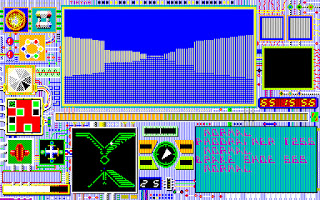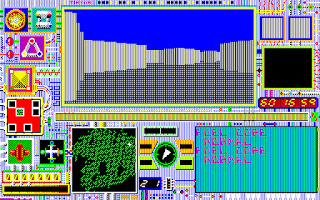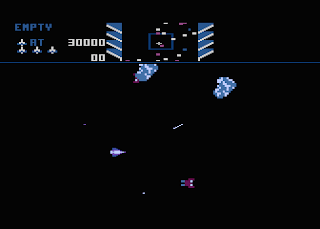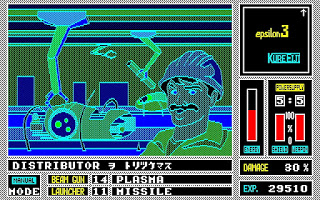Name:Dungeon Master
Number:84
Year:1987
Publisher:FTL
Developer:FTL
Genre:RPG
Difficulty:4/5
Time:15 Hours 40 Minutes
While highly influential in general, Dungeon Master marks a shift in the design of first-person non-vehicle action games from maze games to something with actual gameplay. Even a good chunk of RPGs before this were just complex, multi-level mazes. Meanwhile, while the rest of the gaming world is slowly advancing beyond wireframes, here comes Dungeon Master, looking fantastic and playing great, with this fancy mouse thing. Nothing can compare to what this game accomplished.
 |
These "trolins" are your typical orc-type monsters and usually come in groups like this
|
That's not to say it doesn't have issues with how it looks and controls. The game is very grey, but having unimportant bits desaturated can be a net boon to visibility, outside of those pesky hidden switches or grey keys. Yes, there are some details in the artwork that could be improved, and there could be longer animations, but what is here works well. The primary issue this game has is that its in a dungeon and dungeons are ugly. Its either grey or brown or grey-ish green. If you don't know what you're doing in expanding that, you could very easily make something that looks worse than generic dungeon.
 |
A very bad situation, these wasps poison my characters, so Sonja is just about to die here
|
And on the control front the issues are minor. You can control everything with the mouse, but keyboard shortcuts are common for offensive and movement actions. In the version I played, which is the Chaos Strikes Back port, the numpad controlled my movement. You have the usual forward, back, left, right, but the only turning is left and right. Not much of an issue here though. You can attack by clicking on a weapon, or by QWER and the three letters below these. Attacks (and spells) have cooldown times, based on how strong they were. Meaning you don't want to have your melee fighters cast fireball before entering combat, and enemies with higher defense should be dealt with weaker attacks.
 |
A "giggler" fresh off having stolen a shield, the other having already been stolen
|
The inventory system is limited by both a number of slots and the character's strength. Exceeding the number of slots is possible by getting chests, which you'll need soon enough. Exceeding the strength limit...is possible, but very poor judgment. This decreases your stamina faster, and stamina is something you'll want to keep up. It is possible to restore stamina with potions, and it, like every other point stat restores on its own, but its something one's concerns are better focused on elsewhere.
 |
Another very bad situation
|
One thing I didn't care for was that you didn't really know what an item was or did beyond the name. There are a lot of enchanted items I didn't know if they were any good or not, simply because they were just some item. Weapons didn't really seem to get better as time went on, they just got special abilities. Items that had special uses had to be put in the right hand slot, be they chests that give you more carrying slots or empty potions to be refilled. Its all just mildly inconvenient, not truly bad. Something unnoticable when you're actually playing it.
 |
Sometimes it seems like the dungeon has an actual mind of its own
|
The spell system is part gameplay and part copy protection. You have four sets of six runes and using these runes allows you to successfully cast spells. Success also depends on a character's level. However, I felt the game was biasing me towards casting healing spells and fireballs, as more complex magic spells aren't worth the mana they cost, outside of a few rare situations. Spells are divided by schools, but there's not really any non-offensive spells for wizards (outside of a light spell you need) or decent priest offensive spells.
 |
Throwing a chest at nothing, practically as effective as regular throwing weapons
|
Combat is interesting. In theory you cast a few spells at an enemy, then your melee characters duke it out while the guys behind use ranged attacks. Like most RPGs. The issue is that you can almost never duke it out with enemies. You need to do something commonly called a combat waltz, where you constantly try to run behind an enemy and hit them there. Most enemies have higher health than your party members. This works better on some enemies (and some levels) than others. The environment is very important in this too, as doors hurt everyone. Including your enemies. And in usual RPG fashion, enemies take more damage from some types of damage than others. Positioning is important too, enemies attack the two party members they're nearest, which if they're not in front of you, means one of the squishy mage types is going to have to fight. Its entirely feasible, albeit not practical, to fight off enemies in two different locations at the same time.
 |
A sentient suit of armor, which doesn't take a lot of damage from physical attacks
|
The RPG aspect is very simple. There are four skills, fighter, ninja, wizard and priest. Ninja governs range attacks. Each character can freely advance in each skill, but in practice the front characters are going to be better at fighting and the rear characters better at the rest. However, its still useful to have everyone balanced out, not only for more magical attacks, but also because the characters attributes improve as their stats do, and having more mana and carrying capacity is useful. The latter two are a bigger concern as time goes on.
 |
A mysterious field, there are many of these to figure out
|
Gameplay in Dungeon Master is unsurprisingly enough, a dungeon crawler. Create a party of 4 adventurers and have them explore a 14 (roughly) level dungeon. Preventing you from accomplishing this goal are monsters, puzzles and the party's desire for silly things like "food" and "water". The game has hunger and thirst meters. At first you get plenty of the stuff, but as time goes on it gets in stricter supply. If you're not careful, you can find yourself in a position where your party has no way of getting to water and food sources. After all, your characters are spending many days in a dungeon, its only natural that they want to eat.
Much of the early levels is spent getting used to the mechanics. Befitting its age, the player has to make his own maps, thanks to a lovely mechanic called "spinners", which spin the party around. Its not the first time I've seen it, and it isn't the first time it would be a mechanic in a RPG, but it feels a lot more insidious here. You have to pay extra attention for them, very tricky in a grid-based system where giant rats are barrelling towards you. To survive one needs to be alert and pay attention. That pressure plate in the floor may open a door or it may open an invisible hole in the ground. I'm pretty sure you need to press a few hidden switches and buttons to win, but since you have to be alert its not as big a sin as any FPS guilty of doing it.
 |
Note the cursor on the door button, one of the few times the mouse is useful in combat
|
Once you get used to it, the game really comes into its own. This is where the puzzles really start to shine. These heavily involve the dungeon's environment and get very complex. For a game that's basically the first of its sub-genre it feels like it exploits the mechanics of the genre to the fullest. I had to look up things a few times and it seems like when I did, it was usually because I didn't expect the game to be able to do that. Something of a flaw in my reasoning before now, I admit, but holy crap, this feels like a top-notch fan mod rather than an actual commercial product.
 |
A sample non-material enemy
|
The game has the right length, lacking any real fat to it and just about hitting the practical limit of player offensive ability. Any shorter, and one might not be properly prepared for the final bosses. Any longer, and the player will reach enemies with far too much health. Now admittedly, the last real level has a bit too much in the ways of enemies that take too long to kill. This doesn't make that level bad, just very annoying.
There are a few negatives. Like a few instances where continuing isn't ideal and that it should be time to reload. I can resurrect characters after they die but there's no real boon to this. Resurrection chambers are very far apart from each other and going to them isn't ideal. Further, this permanently lowers the HP of that champion. Despite how it might seem at times, I am trying to play these the way they were meant to be played, its just that doesn't always work out. I also don't care for the "gigglers" or thieving gremlins. They steal an item and then run off. There's one big floor with dozens of enemies and pits in the way of dealing with them, and I don't feel bad about reloading should I end up there and lose an item.
 |
These "wizard eyes" can open the door just as well as you can, which is unfortunate
|
I also found some of the special enemy kinds to be more annoying than worthy foes. Most poison enemies required constant cure potions. I'm pretty sure I used more cure poison ones than regular healing ones. There were enemies that were non-material, which couldn't be harmed by regular attacks. I needed to use one special sword or a specific spell to take them out, which was clever at first, but by the end I was trying to just avoid the ones I could. I finished the game without killing them, so it worked.
Dungeon Master is an interesting game, at times it feels like the last and truly wonderful title of the sub-genre and others it feels like the awkward first game. Its an amazing game and technical achievement. I'm not sure how you could improve upon it, but I'm sure we'll see someone try.
Weapons:
I didn't really notice much difference between the swords I started the game with and the swords I ended the game with, outside of magic powers. Offensive spells, on the other hand, tended to force me to use fireball, with poison attacks being too unreliable and lightning too mana-intensive. Ranged weapons never seemed to be too effective and required too much cleanup. 2/10
Enemies:
There's a nice variety of enemies, albeit ones that fall into the usual category of fantasy monsters. Giant insects, orc-types, undead, beholders, demons and dark lords. There are a few against the grain, but nothing too out of the ordinary. It has a nice progression, but things were getting into the damage sponge range by the end of it. I didn't care for some of the respawning enemies, however. 5/10
Non-Enemies:
There weren't any.
Levels:
There's some interesting highs, the better ones had some very interesting puzzles in-between the fights. Secret searching is pretty good, not only thanks to the methods of finding secrets, but in how they're placed. The lows are mostly just busy-work, having to fight one's way through potentially never-ending meatshields. 7/10
Player Agency:
The method of controlling the characters along a grid works pretty well, compared to later attempts. All my issues really boil down to not being able to change items easily in combat. There's no way to heal in battle easily, going to inventory while fighting is going to end very badly. 7/10
Interactivity:
There's some interesting stuff going on that I haven't seen before. Take secret walls. In a normal FPS, you'd press use against a wall, or maybe shoot it. Here, you can't do the former, and the later does nothing much. Instead you press it, with the mouse. You can also run into walls, which damages you. The game offers a similar amount of cleverness in other aspects. One memorable puzzle involves putting down items to activate pressure plates so you don't get roasted by fireballs. 5/10
Atmosphere:
Despite lacking music or any kind of ambient sound, Dungeon Master did a good job of making the player feel like he's deep in a dungeon. Too many games gloss over the whole eating and drinking aspect of dungeon crawling. 4/10
Graphics:
High-quality for the era, but now just competent. The game mostly suffers in that what its depicting most of the time isn't going to look great no matter how you render it. 4/10
Story:
Not something that really matters for the most part. It is cool that one should figure out that Lord Order isn't a friend, but otherwise it doesn't exactly have much of a presence. 1/10
Sound/Music:
There's no music in the version I played, but there were action sound effects. Simple but effective. 3/10
That's 38. I'm giving it 2 more since its such a vital, if understated game. For a final of 40. That's the lowest of my recommended category, as the 30s usually fall under recommended if you like that sort of thing. I don't really need to go into the reviews, since its more or less a beloved classic. Its not really a FPS, but its DNA would contribute quite heavily to the genre.
FTL Games will return with the expansion Chaos Strikes Back at some point in the future. The next real RPGs I'll touch upon are the Ultima Underworld games.
I'm trying to shift the upcoming games between genres and nationalities. Expect a Japanese FPS, a racing game, an American FPS, and then an Intellivision game. It turns out I was unable to play The Wreck.


























































